What is Mobile Learning For Businesses? A Detailed Guide
Wondering what is mobile learning for businesses? Discover how mobile-based training improves engagement, retention, and performance.
Wondering what is mobile learning for businesses? Discover how mobile-based training improves engagement, retention, and performance.

Most companies think that training can only happen when your team is sitting in a room with a whiteboard. However, this traditional way of training has become slow and expensive, and is often forgotten within a few days.
This is where mobile learning for businesses steps in.
Imagine delivering targeted, bite-sized training straight to your team’s smartphones, whether in the office or across the country. It’s convenient, smarter, and proven to improve retention.
In this guide, we’ll explain what is mobile learning for businesses and why it might be the upgrade your training desperately needs.
Mobile learning, also known as m-learning, is a training method that allows employees to access learning materials through their mobile devices. Instead of sitting through long training sessions or being tied to a desktop, employees can engage with short, interactive lessons on their phones.
In the business world, this approach has already transformed how teams learn, upskill, and stay aligned with their roles.
In fact, according to GlobeNewswire, the global mobile learning market is expected to reach $80.1 billion by 2027. This shows just how fast companies are accepting mobile-first training strategies.

People often confuse mobile learning, traditional e-learning, and microlearning. However, they aren’t the same.
Traditional eLearning typically involves long-form content delivered on desktops or laptops. Examples include full-length video lectures, detailed PowerPoint modules, or hour-long compliance courses hosted on a learning management system (LMS).
On the other hand, microlearning focuses on short, targeted learning experiences, usually taking up 3 to 10 minutes each. It isn’t exclusive to mobile and can be delivered via desktop.
As for mobile learning, it is specifically designed for smartphones and tablets. It combines the flexibility of mobile access with the convenience of microlearning.
Example: Instead of watching a 45-minute video on safety protocols at a desktop, a field technician receives a 5-minute mobile module with a quick video, a checklist, and a short quiz.
Here’s why mobile learning stands out for businesses:
Mobile learning meets employees where they are, in a literal sense. Whether on the factory floor, in the field, or working from home, training is available 24/7 through their smartphones. This “anytime, anywhere” access eliminates the need for rigid schedules or in-person sessions.
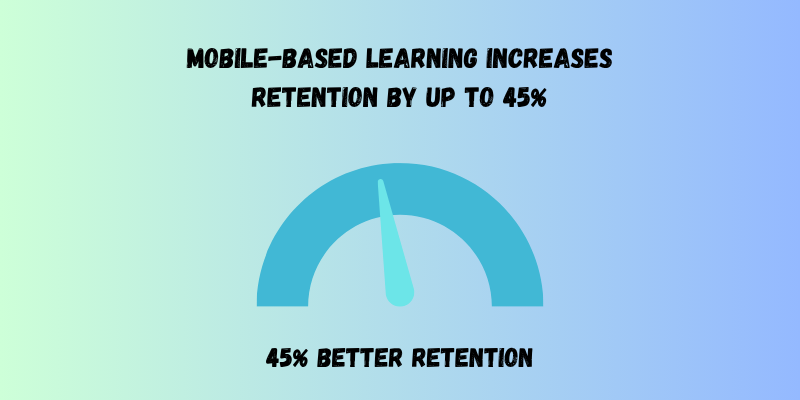
Mobile learning improves employees’ ability to absorb and apply knowledge. According to research, mobile-based learning increases retention by up to 45%.
This shows that short, interactive modules keep learners more engaged and focused. Because of this, employees can now receive training in smaller, less intimidating sessions, which leads to better understanding and fewer dropouts.
Mobile learning reduces training costs by removing the need for classrooms, instructors, printed manuals, and travel expenses. It’s also faster to roll out, making it ideal for onboarding, compliance, or product updates.
Mobile learning comes with significant advantages. Not hype, just real, measurable impact. Here are the five significant benefits of mobile learning for businesses:
Mobile learning allows employees to access short, relevant lessons exactly when needed. It’s like having a personal coach in their pocket that guides them step by step through every task at hand.
This “just-in-time training” access improves memory, reduces confusion, and helps people learn while doing.
Research also shows that 68% of employees prefer mobile learning because it fits their schedules and allows them to learn on the go.
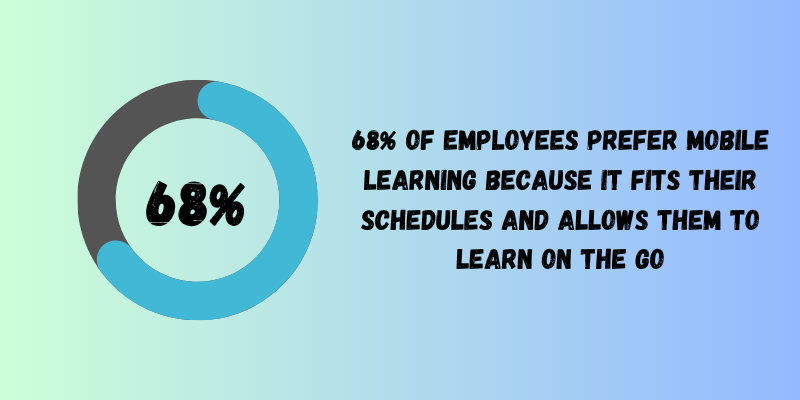
M-learning often includes features like in-app comments, group discussion, and sharing tools. These allow coworkers to learn from each other, ask questions, and give real-time feedback.
Moreover, people learn better when they do it together. Peer learning builds trust, increases participation, and keeps content more relatable and practical. It also improves performance significantly, meaning employees are more likely to finish training.

Instead of dumping all the information at once, mobile learning delivers knowledge in smaller chunks over time. Interestingly, most people forget 50 to 70% of their learning within a week. That’s why continuous reinforcement is essential, as it keeps lessons fresh.
According to Brandon Hall Group, reinforcing learning and incorporating it into daily tasks exactly when needed has been shown to enhance employee productivity by 25%.
Employees can complete mobile courses much quicker because they’re short, interactive, and easier to digest. That also makes them more likely to finish the training in the first place.
Slow or tedious training often gets skipped, making mobile content far more valuable, especially when it includes visuals. Even studies support this claim by showing that mobile learners finish their training modules 45% faster than other learners and are more engaged.
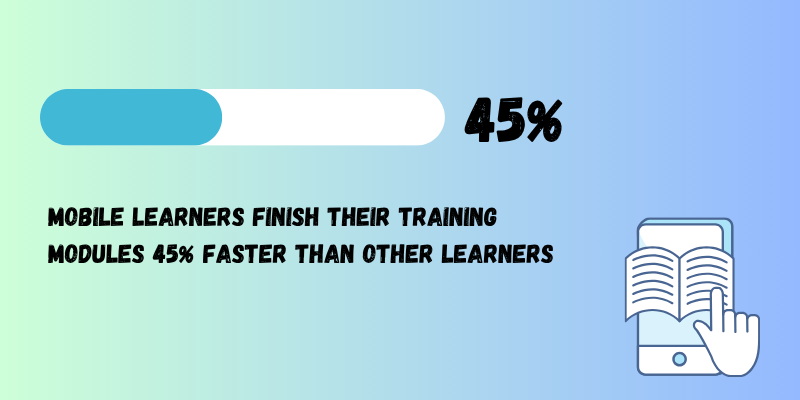
You don’t need classrooms, printed materials, or travel expenses to teach your employees something new anymore. It can now be done from anywhere.
When a course is created, it can be shared instantly with 10 or even 10,000 employees immediately. It’s ideal for growing teams, remote staff, or companies needing to quickly train people in different locations. You can also add a quiz at the end to determine how much an employee has learned.
While mobile learning for businesses offers enormous benefits, it’s not without its challenges. Many companies struggle to get it right because it can be tricky. Let’s break down the most common problems and how to solve them.
Not all employees use the same devices. Some have Android phones, while others use iPhones or older tablets. The screen sizes, app versions, and operating systems also vary.
If your mobile learning platform is not optimized for different devices, your employees may face layout issues, slow performance, or even app failure.
Solution: The best approach is to choose a mobile learning solution that supports responsive design and works across iOS, Android, and web browsers. Most top LMS platforms for corporate training, such as Coursebox, offer fully responsive mobile experiences that resolve this issue.
Mobile learning for businesses needs to be simple, visual, and interactive. It’s because employees usually don’t have the time to learn outside their 40-hour workweek.
If your content is boring or hard to read, your employees will immediately bounce back. They may ignore the lesson or click through without actually learning anything.
Solution: Use a mobile-first content design strategy. Break up lessons into short segments (3–5 minutes), use large fonts, interactive buttons, and media like videos or voice notes.
Our smartphones are full of distractions, especially in this age of social media. Due to this, it’s easy for learners to lose focus when training on a mobile device. Even well-designed lessons become ineffective if users aren’t mentally present.
Solution: The only way to overcome this is by using gamification techniques for corporate training, like progress bars, points, or badges, to make training fun and rewarding.
Additionally, push short reminders or micro-challenges instead of long-form content to improve employee focus.
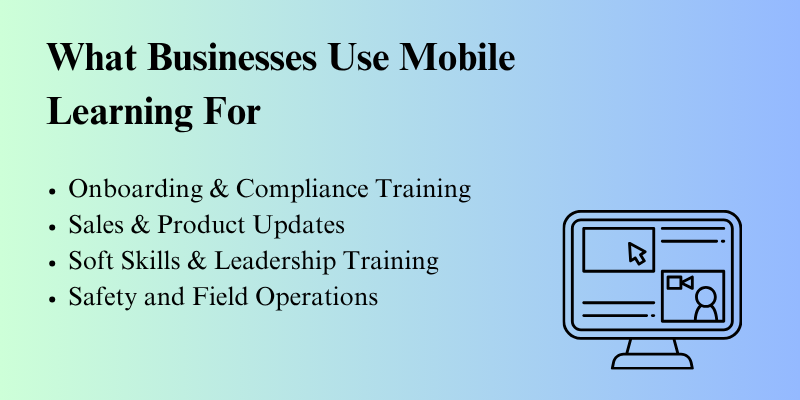
Many companies use mobile learning to improve employee performance and keep their teams growing. But how exactly are companies putting mobile learning to work?
Here are some of the most common and effective use cases:
New hires don’t always have time (or patience) for hours of training videos or long documents. That’s where mobile learning for businesses comes in and changes the game with short, structured onboarding lessons.
Whether health and safety, data privacy, or company policies, mobile delivery ensures your team completes required training on time and with proof. Learners can easily complete modules on their phones, even before their first day.
Sales teams constantly move to find customers and build a customer base. They always need fast access to product updates, pricing, or new selling points to promote the brand.
Mobile learning is handy as it keeps sales reps in the loop without pulling them away from their work.
Skills like communication, problem-solving, and leadership aren’t built overnight. They develop as a result of ongoing learning and introspection.
The only way to support this development is through bite-sized leadership lessons and real-life scenarios. This way, the employees can learn and apply new skills at the moment, not just in the classroom.
Returning to a computer for training isn’t realistic for construction, logistics, or healthcare workers. To tackle this issue, companies now offer training through mobile learning.
Field workers can access this knowledge on-site, whether it’s a quick refresher on a safety procedure, how to use new equipment, or what to do in an emergency. It reduces risk, improves safety compliance, and keeps everyone protected.
Mobile learning is already transforming how businesses train their team. But that’s just the beginning. Here’s what the future holds for mobile learning and how it can actually be made better:
Artificial intelligence is making learning smarter. It can track user behavior, learning speed, and interests, and then suggest the right courses at the right time. It’s like having a personal coach for each employee.
AI Chatbots are also becoming a key tool. They can answer real-time training questions, quiz users on previous lessons, or guide them through a process without human support.
Not just that, studies have shown that AI in training has the potential to increase employee efficiency by up to 30%. That’s why companies are more inclined towards it.
Augmented Reality (AR) and Virtual Reality (VR) are bringing hands-on training to mobile devices. Instead of watching a video on safety procedures, employees can practice in a simulated environment. All they need is a mobile phone or a VR headset.
This is especially useful in industries where real-life mistakes can be dangerous or costly, such as construction, manufacturing, or healthcare.
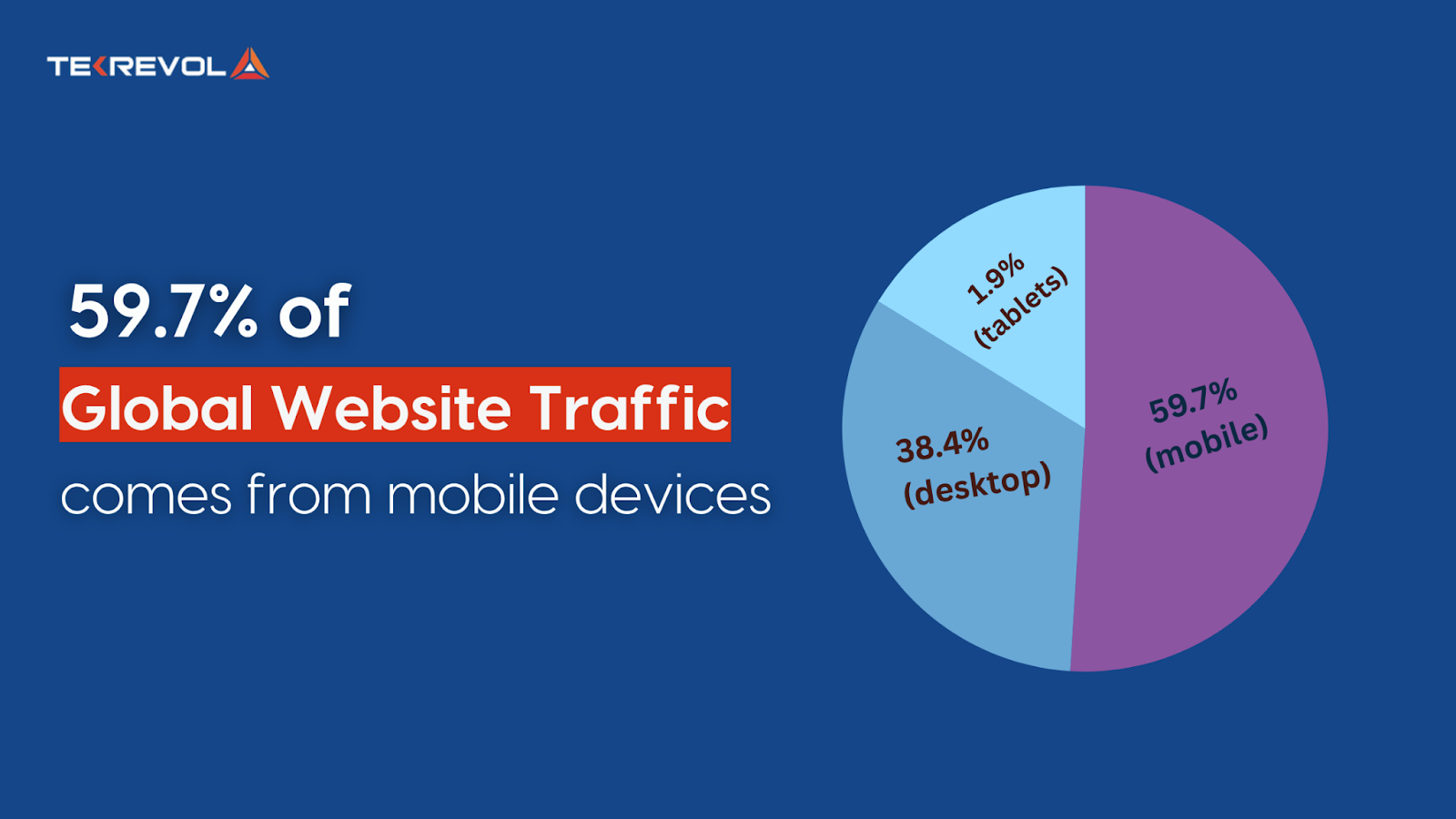
More than half (almost 59.7%) of all internet traffic now comes from mobile devices, and this trend isn’t slowing down anytime soon. For businesses, this means mobile learning will remain the go-to method for training frontline, hybrid, and remote teams.
Platforms that don’t prioritize mobile UX will get left behind. The future is built for small screens with significant impact, from better push notifications to voice-activated learning.
If you’re exploring mobile learning for businesses, chances are you’re already feeling the pressure of creating a training module and managing it. The traditional tools you might be using now aren’t built for speed. But with AI, everything becomes easier.
This is where Coursebox fits right in with its AI-powered training platform.
It is designed to take the load off your shoulders. With our software, you can instantly turn your content into interactive courses, auto-generating videos, quizzes, and assessments with personalized AI feedback.
Ready to see how it works? Start your free trial today!
Yes. Studies show that mobile learning improves knowledge retention by up to 45% compared to desktop-based learning. Its bite-sized modules and accessibility help employees remember and apply what they learn.
Ideally, mobile learning modules should be 3 to 7 minutes long. This length supports engagement and retention. These short bursts fit easily into breaks or between tasks and reduce cognitive overload.
Use platforms such as Coursebox with built-in analytics. Through it, you can view module completion rates, quiz scores, time spent, and overall course progress. This helps you optimize your content more and measure the ROI of your mobile training modules.
Some training types that work best on mobiles include compliance training, onboarding, microlearning, safety drills, product updates, and soft-skill refreshers. All these perform well on mobile devices, as they fit better into busy work schedules.
